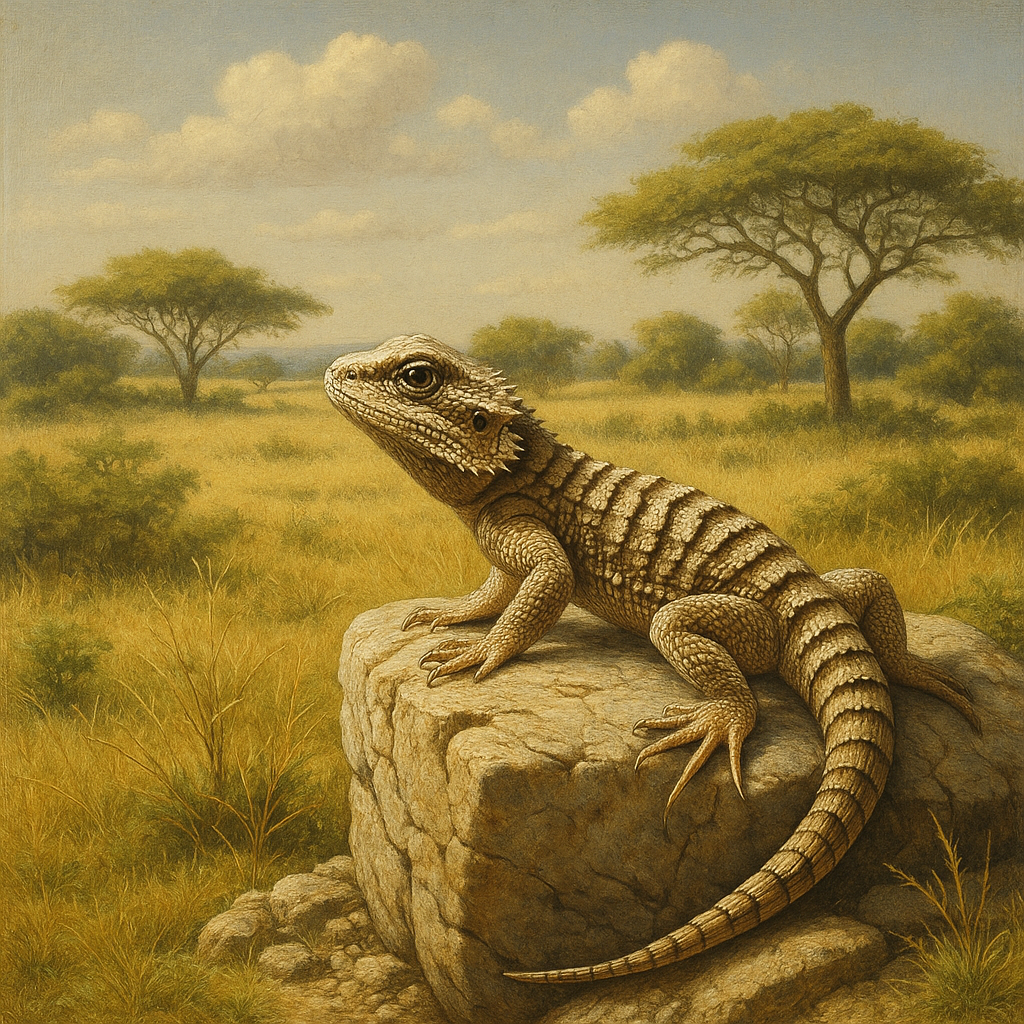Salt Lizards
"Lick a stone wrong in the Stonejaws and you might find it looking back." -Field Notes of Scholar Arven Crogdon, presumed devoured
Few creatures are as easily overlooked, or licked, as the Salt Lizard. Native to Everwealth’s jagged, sun-bleached highlands and mountain ridges, this small reptile lives camouflaged against stone and salt of the arid southern reaches bordering Kathar. Chalky-white, dry-scaled, and shaped like a loose rock fragment until it darts away, the Salt Lizard is a master of stillness and survival. Yet beneath that simplicity lies a biological oddity: a body so saturated with sodium and mineral elements that some scholars debate whether the creature is animal or animated salt deposit. Salt Lizards are both culinary treasure and rural superstition. Some villages believe finding one near your tent is a sign of good weather. Others warn not to eat a lizard on summer day, lest your blood turn to chalk. Hunted by opportunists and cooks alike, it is not prized for its meat, but for what’s left behind when it’s dried and ground, “lizard salt,” a tangy, potent seasoning found on the tables of Everwealth’s wealthiest gluttons, especially when infused with vinegar or saffron. In poorer regions, lizard-salt is a mark of luck, and a single dried tail can be traded for several loaves of bread. In any case, necessity and curiosity have culminated into the Salt Lizard's continued presence in greater Everwealthy culture for likely many generations to come.Basic Information
Anatomy
The Salt Lizard is a small reptile averaging 6 to 8 inches in length, with a slightly flattened body and blunt snout. Its tail makes up nearly half its length and tapers to a fine mineralized tip, used in both defense and thermoregulation. The creature’s coloration ranges from pale gray to nearly white, closely mimicking the granitic and salt-flaked terrain it inhabits. The skin is dry, grainy, and textured with irregular ridges that trap dust and blend perfectly with its surroundings. Upon closer inspection, its scales appear translucent in places, and under strong light, can refract faint prisms, an effect attributed to their crystalline salt content. Its claws are short but needle-sharp, suited for gripping coarse rock. Internally, its organs show unusually high saline saturation. Dissection reports suggest that its blood contains crystallized sodium deposits suspended in viscous plasma, while the stomach linings have been found lined with calcium and rockdust fragments. Some believe it does not digest in the conventional sense, but rather "absorbs" minerals directly into its body tissues through a process akin to geological layering.
Genetics and Reproduction
Salt Lizards reproduce sexually, with mating typically occurring during the first warm rains of late Aquamarine (March). Females lay 1-3 leathery eggs in shallow crevices filled with warm pebbles, which act as heat incubators. The eggs harden quickly, often mistaken for mineral nodules or lumps of quartz. Hatchlings emerge after 3-4 weeks and begin foraging within a day. Genetic variance is minor between clutches, and regional coloration is often more environmental than hereditary.
Growth Rate & Stages
Hatchling (0-2 weeks): Speckled stone coloration; vulnerable and soft-scaled.
Juvenile (2 weeks-3 months): Salt pattern emerges, camouflage improves.
Adolescent (3-6 months): Begins storing salt in scale sheaths.
Adult (6+ months): Fully mineralized exterior; capable of breeding.
Ecology and Habitats
Salt Lizards thrive in rocky, arid elevations where moisture is scarce but salt minerals are plentiful. They are most commonly found in:
- The dryer reaches of The Stonejaw Mountains most prevalently.
- The Cloudrend Mountains commonly but absent towards the colder peaks.
- The Woodswatch Mountains least-commonly but still in large spatterings across the mountain range.
- Stretches of The Battlement Cliffsbordering arid Kathar.
- High reaches of The Grandgleam Forestas-well but sparcely.
Dietary Needs and Habits
Salt Lizards are insectivores, consuming ants, beetles, grubs, and the occasional fungus sprout. However, their true diet includes:
- Lichen and moss, particularly those clinging to mineral veins.
- Deposits of dried animal urine, from which they extract salts.
- Dried blood, a rare delicacy they will scrape from old hunting kill sites.
Biological Cycle
The Salt Lizard does not hibernate, but slows its activity during colder months, seeking sunlit ledges or warm mineral surfaces to remain active. During droughts, it enters a low-function metabolic state, sealing itself in shallow rock pockets and absorbing ambient moisture through its skin. These states can last weeks without food or movement, leading some to believe they are statues until one blinks.
Behaviour
Salt Lizards are skittish and non-aggressive, often freezing in place when approached. They exhibit complex spatial memory, remembering safe ledges and scent trails over weeks. When pursued, they perform sudden, jerking movements that mimic the fall of loose gravel, a form of mimicry that throws off predators. They live solitary lives, communicating with mates through body vibration and tail flicks. While not intelligent by any sapient measure, they are noted for their wariness and refusal to return to a disturbed location for several weeks.
Additional Information
Perception and Sensory Capabilities
The Salt Lizard has poor vision, relying mostly on smell and vibration to navigate. It detects motion through minute tremors in the stone and can remain motionless for hours. Its tongue contains specialized receptors attuned to chemical changes in the soil, allowing it to locate fresh rainwater, prey trails, and potential predators with a single taste of the air.
Scientific Name
Scincoidea salarius.
Origin/Ancestry
Believed to have diverged from the region’s more common rock lizard species during the early Lost Ages. Scholar’s Guild records indicate they first appeared in cooking records before formal biological classification.
Conservation Status
While common in most mountain regions, overharvesting by salt collectors and gourmands has caused localized collapses in some areas, especially near Woodswatch mining trails. The Scholar’s Guild recommends limited trapping per household, but enforcement is rare. Used commonly by impoverished folk or cliff-dwelling outposts as emergency salt supply.
Geographic Distribution



Comments